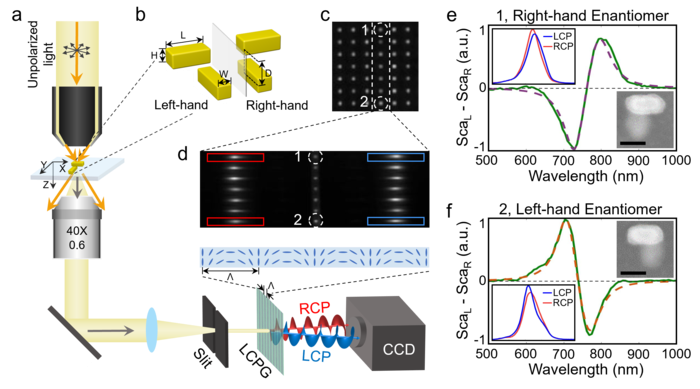The function of a molecule or nanostructure is determined by its 3D configuration. A left-handed amino acid, for example, can be beneficial to human health, whereas its right-handed compartment can be harmful. Today’s modern optical imaging methods can precisely track down a molecule or a nanostructure, but resolving its 3D interior structure necessitates extra spectroscopic data.
 A schematic drawing of the LCPG-based polarization-dispersive spectrometer. The inset illustrates the director’s distribution of the liquid crystal in the grating. B, the structure of the vertically coupled nanorod pairs used in this work. C, the dark-field image of an array of vertically coupled nanorod pairs with different geometrical parameters. The period of the array is 3 μm. D, a spectral image of an array of nanorod pairs labeled in c. The RCP and LCP components are labeled with red and blue boxes, respectively. E and f are the SCD spectra of samples 1 and 2 in c, respectively. The insets show the correlated SEM image of samples, as well as the left-hand and right-hand circularly polarized components of the scattered light of sample labeled in d. Scale bar: 100 nm. Image Credit: Shuang Zhou, Jie Bian, Peng Chen, Mo Xie, Jie Chao, Wei Hu, Yanqing Lu, and Weihua Zhang.
A schematic drawing of the LCPG-based polarization-dispersive spectrometer. The inset illustrates the director’s distribution of the liquid crystal in the grating. B, the structure of the vertically coupled nanorod pairs used in this work. C, the dark-field image of an array of vertically coupled nanorod pairs with different geometrical parameters. The period of the array is 3 μm. D, a spectral image of an array of nanorod pairs labeled in c. The RCP and LCP components are labeled with red and blue boxes, respectively. E and f are the SCD spectra of samples 1 and 2 in c, respectively. The insets show the correlated SEM image of samples, as well as the left-hand and right-hand circularly polarized components of the scattered light of sample labeled in d. Scale bar: 100 nm. Image Credit: Shuang Zhou, Jie Bian, Peng Chen, Mo Xie, Jie Chao, Wei Hu, Yanqing Lu, and Weihua Zhang.
CD spectroscopy is the most frequently used approach for this. Real-time monitoring and identification of specific functional nano-units will be possible if CD spectroscopy is combined with an imaging technique. It will have a wide range of applications in nanoscience and biology.
Consequently, existing CD spectrometers rely on polarization modulation of excitation light and necessitate complex multi-step measurements, preventing CD spectroscopy from reaching its full potential.
To address this problem, a team of researchers led by Professor Weihua Zhang and Professor Yanqing Lu from the College of Engineering and Applied Sciences, Nanjing University, China, and co-workers established a polarization-dispersive imaging CD spectrometry method in a recent paper published in Light Science & Application. Using a nano-patterned liquid-crystal polarization grating (LCPG), the new method works on signals rather than the excitation light.
The LCPG can efficiently scatter the left- and right-handed circularly polarized components of optical signals to different directions (overall diffraction efficiency >95% at optimal wavelength), allowing the CD spectrum to be collected in a single shot.
Researchers used the new approach to examine a model system, namely the coupled plasmonic nanorod pair, and conceivably demonstrated that the new approach is comparable to traditional CD spectroscopy when nonpolarized excitations are used.
The LCPG is a critical component of the new CD spectrometer. Unlike traditional polarization components, which are often challenging to adjust and use, the LCPG is simple, precise and reliable.
The researchers state, “The LCPG is an ideal solution for polarization-related measurements. First, its accuracy is guaranteed by theory. Mathematically, the space-variant geometric phases for LCP and RCP light generated by the LCPG are conjugated. As the result, they are always split into the ±1th order of diffractions with absolute equal efficiency.”
“This polarization dispersion behavior is non-dispersive, accurate, and highly efficient. Secondly, the LCPG is a mature technique, and high-quality LCPGs can routinely be fabricated in research labs. To be honest, we were surprised to see that it worked so well in the single nanostructure CD measurements,” they added.
Another critical aspect of single nanostructure CD spectroscopy is determining how to interpret the information and collect the interior 3D structural profile of the sample. The paper investigated a special case, coupled plasmonic nanorods, and demonstrated that geometrical parameters are highly related to spectral features.
The scientists further explained, “A single nanostructure’s CD spectrum is very different from the result of ensembles. In addition to the interior of the nanostructure, the spectrum is also related to its orientation, as well as the detailed excitation and observation geometries. To fully understand the complexity, more comprehensive theories are needed. We are currently working on it.”
Finally, due to the obvious LCPG’s near-unit diffraction performance, the polarization-dispersive CD spectrometer is an ideal tool for measuring weak signals, such as circular polarized luminescence or Raman scatterings from individual nanostructures.
Besides the plasmonic nanostructures, we also tested the polarization-dispersive imaging spectrometer with single quantum dot luminescence, and the system works perfectly. We believe that it is even capable of doing single-molecule CD measurements. That is our big goal!
Weihua Zhang., Study Team Lead and Professor, College of Engineering and Applied Sciences, Nanjing University
Journal Reference:
Zhou, S., et al. (2022) Polarization-dispersive imaging spectrometer for scattering circular dichroism spectroscopy of single chiral nanostructures. Light: Science and Applications. https://doi.org/10.1038/s41377-022-00755-2.